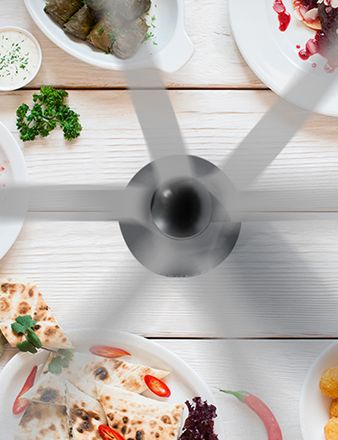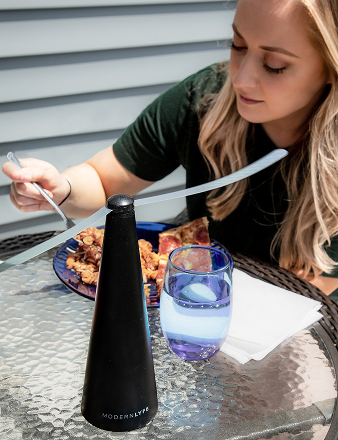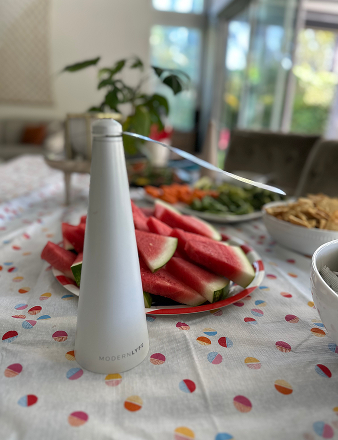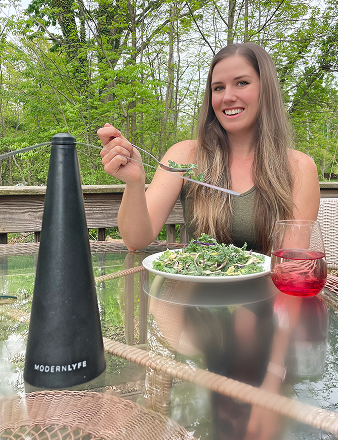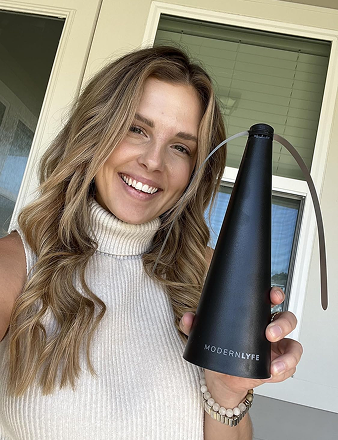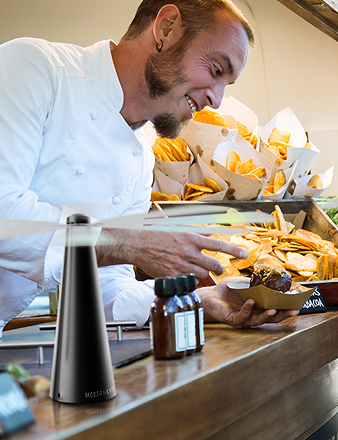A food fly trap uses bait—like apple cider vinegar—to lure flies into a container they can't escape. It's a low-cost, non-toxic way to control pests, especially in the kitchen. The trap works by using a fly's natural attraction to the scents of fermentation and decay against it.
Winning the Battle Against Kitchen Flies
We’ve all been there: you walk into your kitchen and find a swarm of tiny flies buzzing around the fruit bowl. It's frustrating and unhygienic, as these pests can contaminate food and surfaces.
While swatting them one by one is a temporary fix, it's not a real solution. To reclaim your space, you need a better strategy. This guide breaks down everything you need to know about food fly traps so you can restore peace and cleanliness to your home.
What You Will Learn
This is your complete guide to solving a fly problem. We'll cover the science of what attracts flies and the best spots to place a trap for maximum impact.
You’ll get practical advice on:
- Why different baits and trap designs work.
- A clear comparison of trap styles, from sticky paper to modern baited containers.
- How to choose the right trap for your kitchen, patio, or other areas.
- Step-by-step instructions for making effective DIY traps with household items.
After reading this, you'll have a smart, targeted strategy that not only resolves your current fly issue but also helps prevent future ones.
Next, we'll explain how these traps use a fly's own biology against it, which is the key to choosing a solution that actually works.
How Food Fly Traps Actually Work
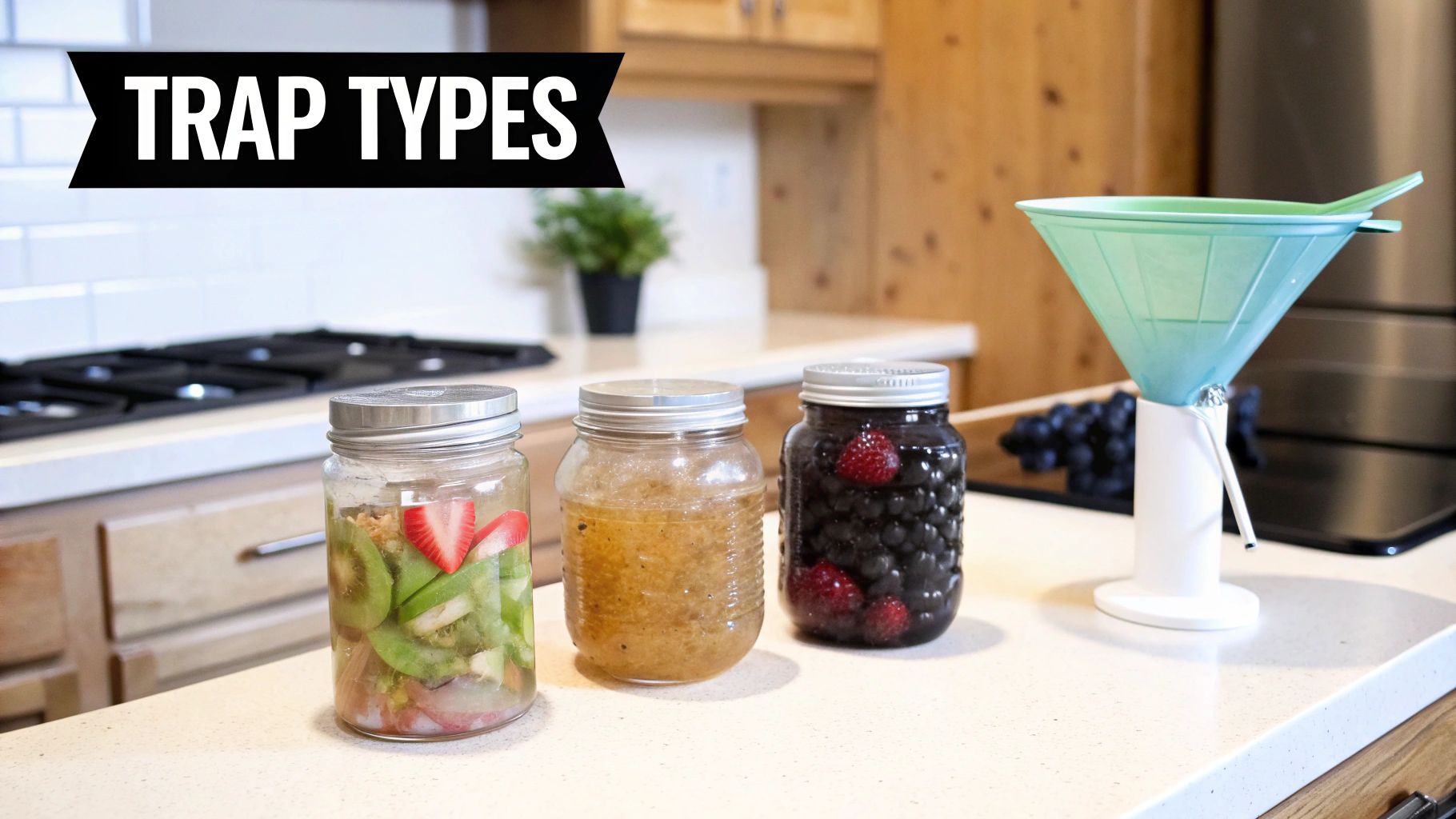
A food fly trap is a master of deception. It lures flies with an irresistible scent and then traps them. The strategy is simple: lure them in, then make sure they can’t get out.
The process starts with the bait, or attractant. Different flies are drawn to different smells, so the trap must send the right signal.
The Power of Scent
For common pests like fruit flies, nothing works better than the smell of fermentation. The sweet, vinegary aroma of overripe fruit or wine acts as a homing beacon, signaling an ideal place to eat and lay eggs. That’s why many traps use baits like apple cider vinegar to mimic these scents.
House flies, however, often prefer protein-based or extremely sweet scents. You have to match the bait to the fly you want to catch. The goal is to create a scent so appealing that it overpowers any other food source in the room.
The market for non-toxic solutions is growing fast. The global fly trap market, valued at USD 294.1 million, is projected to reach USD 517 million. This growth highlights the public's preference for chemical-free pest control. You can read more about this trend at Future Market Insights.
Visual Triggers and Trap Design
Smell isn't the only attractant. Many traps also use visual cues. Flies are drawn to specific colors, like yellow, which is often used for sticky traps. Other designs, like electric zappers, use ultraviolet (UV) light that many flying insects can see and are naturally drawn to, especially in the dark.
Once the scent or light has drawn the fly in, the trap’s physical design takes over.
- Container Traps: These use a funnel or small holes that are easy for flies to enter but difficult to exit.
- Sticky Traps: These use a non-toxic glue. Once a fly lands, it’s stuck permanently.
The best traps combine a potent attractant with a foolproof trapping mechanism. It's a one-two punch that ensures once a fly investigates the bait, its journey is over.
Understanding these mechanics is the first step toward winning the pest battle and learning how to keep flies away from food. Once you know what makes them tick, you can choose the right trap to clear them out.
Comparing The Most Common Food Fly Traps
After you know what attracts flies, it's time to choose your trap. The right one depends on your specific needs, like where you'll place it, whether you have pets, and how much maintenance you're willing to do.
Let's break down the three most common types.
Each style has its pros and cons. Adhesive traps are simple, container traps are discreet and reusable, and UV zappers offer heavy-duty control for larger problems. Your choice should match the trap’s design to your pest issue and the space you're protecting.
This image shows how simple it is to make a basic trap with items you already have.
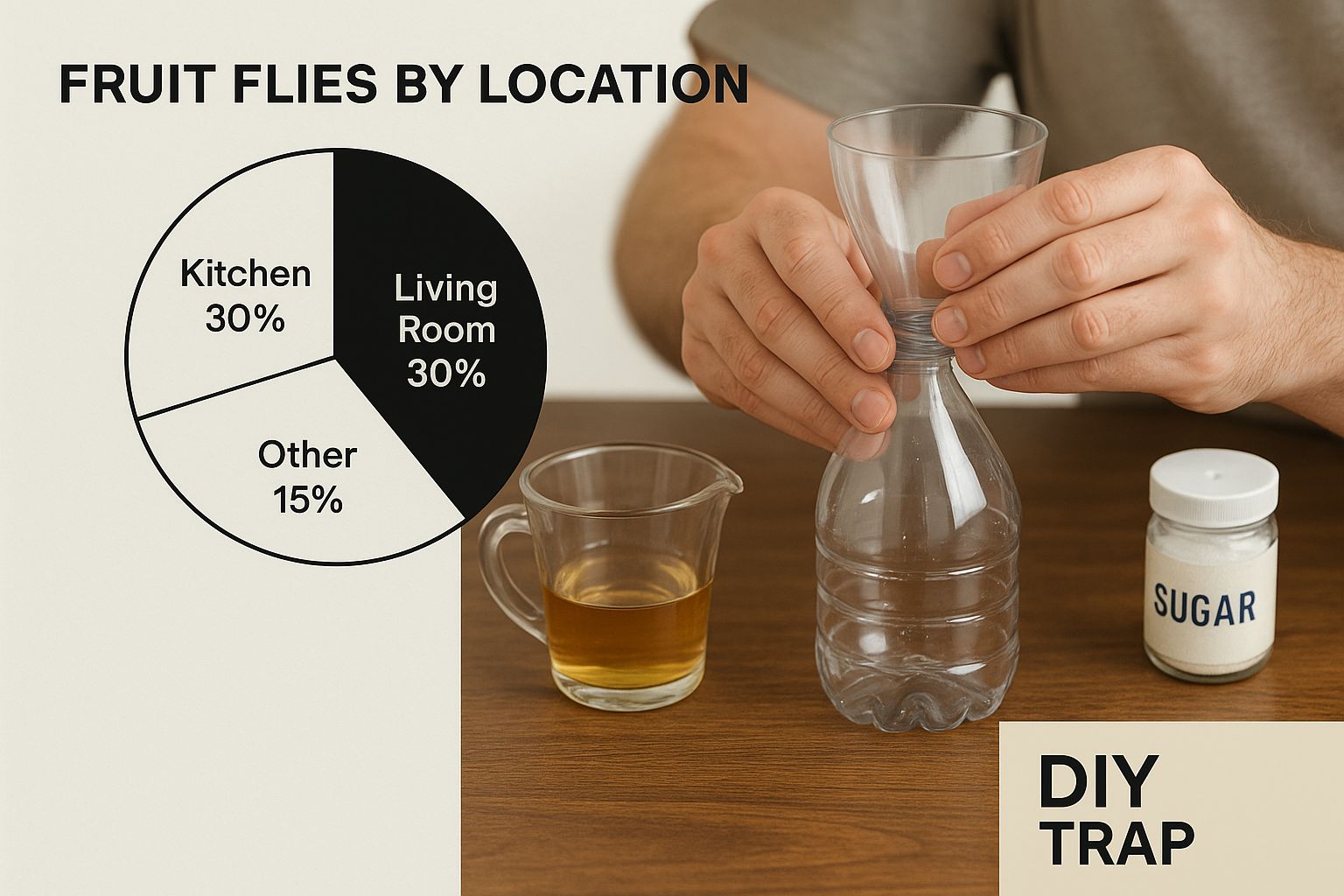
As you can see, a few household items are often all it takes, making a DIY approach a great first line of defense.
Food Fly Trap Feature Comparison
This quick comparison will help you match the right tool to the job.
| Trap Type | Best For | Pros | Cons |
|---|---|---|---|
| Adhesive Sticky Traps | Greenhouses, near houseplants, and covered patios. Great for catching gnats and other small flying pests. | Simple to set up, affordable, and completely silent. | Can look messy once covered in bugs. They may also trap beneficial insects outdoors. |
| Baited Container Traps | Kitchen counters, dining areas, and anywhere you need a discreet solution for fruit flies or house flies. | Traps bugs out of sight, many are reusable, and they're highly effective. | Requires bait refills and cleaning. The bait's scent might be noticeable up close. |
| Electric UV Light Zappers | Larger spaces like garages, backyards, or commercial kitchens with serious, widespread fly infestations. | Highly effective for large volumes of insects, works 24/7. | The zapping sound can be loud, and they kill beneficial insects along with pests. |
There is no single "best" trap—it's about what works for your space and your pest problem.
A Closer Look at Each Trap Style
Adhesive Sticky Traps
Sticky traps are simple. They are typically bright yellow cards or long ribbons coated in a sticky, non-toxic glue. When flies land, they get stuck for good. Their main advantage is their simplicity: no bait to mix and no power required. Just hang them up and you're done.
Baited Container Traps
This is the most common style for kitchen pests like fruit flies. These traps use a liquid or solid bait inside a container with a specially designed lid, often with a funnel-shaped opening. The bait's scent lures flies in, but the design makes it nearly impossible for them to escape.
The main benefit is containment. Captured flies are hidden inside, making this a better option for countertops and tables. Many are also reusable—just empty, rinse, and refill.
This is a massive market, as many restaurants and homes need a solution. The global fly traps market is projected to reach USD 388.5 million by 2031. The commercial sector's demand shows how critical effective fly control is anywhere food is handled.
Electric UV Light Zappers
For a more powerful, wide-ranging solution, electric UV zappers are the heavy hitters. These devices use an ultraviolet light bulb to attract flying insects. When the bugs fly toward the light, they pass through an electrified grid that kills them instantly. These are best for large areas or severe infestations where other traps can't keep up. However, they are not selective and will eliminate any insect drawn to the light.
For smaller, more focused problems like a fruit fly invasion, learn how to control fruit flies with targeted methods in our other guides.
Picking the Right Trap for Your Space
There is no one-size-fits-all food fly trap. The small container trap that works in your kitchen would be useless on a busy restaurant patio. To solve your fly problem, you have to match the trap to the environment.
For Your Home Kitchen
In your kitchen, you need a trap that is effective, discreet, and safe.
-
Baited Container Traps: These are your best bet. They hide trapped flies and are perfect for countertops, sinks, or fruit bowls. The bait is almost always a non-toxic, food-based lure.
-
Adhesive Sticky Traps: These work well but can become unsightly. They are better for out-of-sight spots like inside a pantry, under the sink, or near a trash can.
The goal at home is targeted, low-profile control. For a smaller space and problem, a quiet and safe food fly trap is the ideal choice.
For Commercial and Restaurant Settings
A restaurant kitchen or dining hall presents a much bigger challenge. The large amounts of food and constant traffic create a paradise for flies. Here, power and capacity matter more than aesthetics.
A business needs serious, continuous control to meet health standards. The trap must handle a constant stream of pests without requiring constant maintenance.
This is where you need heavy-duty solutions:
-
Electric UV Light Zappers: These are the workhorses of commercial pest control. Mounted high on walls away from food prep areas, they provide powerful, 24/7 protection and are a staple in professional kitchens.
-
Large-Scale Adhesive Traps: Often found in back-of-house areas, these giant sticky traps can hold thousands of flies. They offer a silent, chemical-free alternative to zappers and provide a clear visual of the infestation level.
For Outdoor Patios and Gatherings
Outdoor spaces are tough because you're fighting an endless supply of flies. The goal isn't to eliminate every fly but to create a protected zone around your guests and food.
A heavy-duty outdoor food fly trap is essential here. You need a model that can hold a large number of flies and uses a powerful, long-lasting bait that competes with other outdoor smells. It must also be weather-resistant to withstand sun, wind, and rain.
Effective DIY Food Fly Trap Solutions
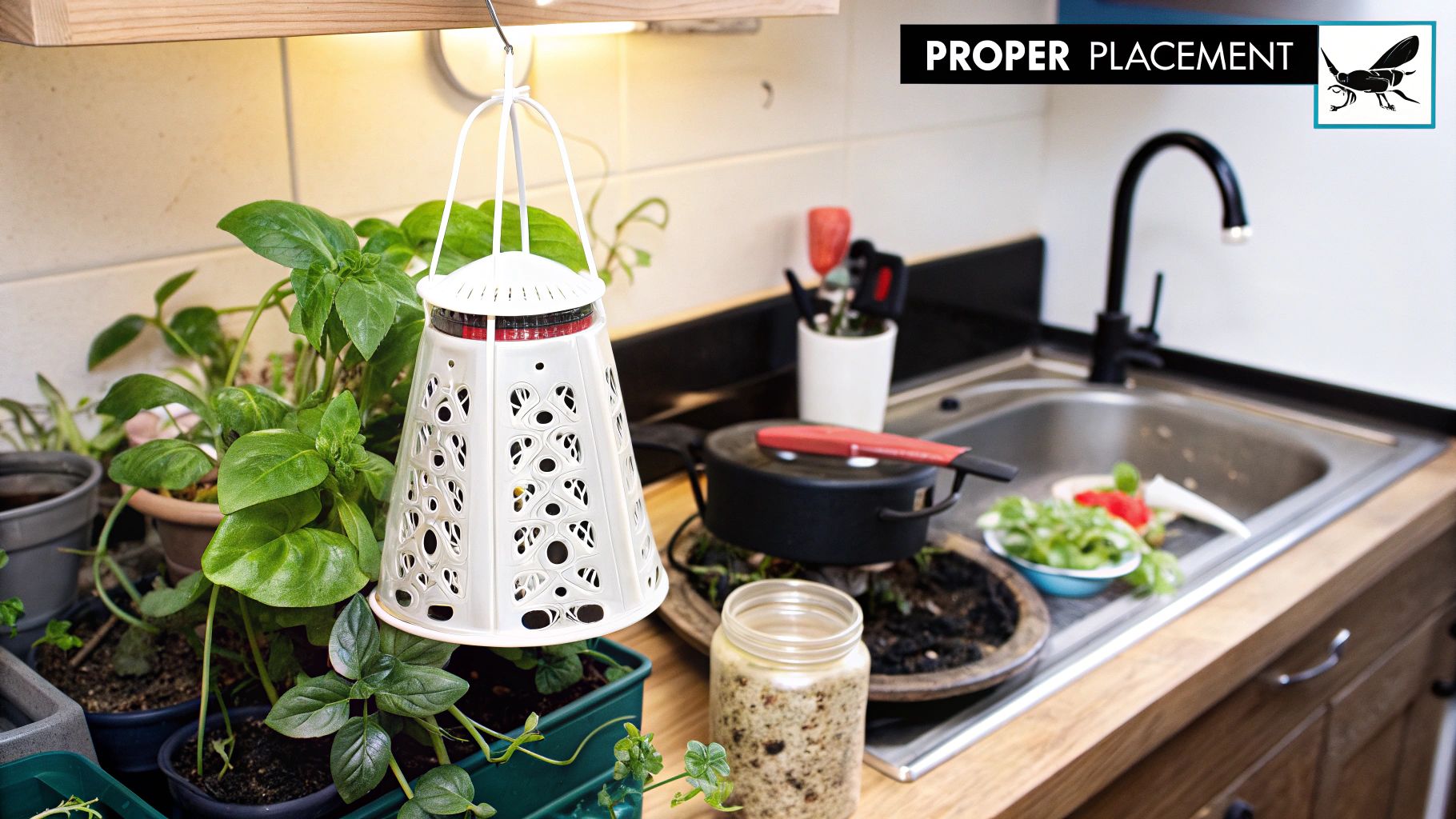
Sometimes the simplest fix is the best. Before buying a commercial trap, you can often control a fly problem with a DIY food fly trap using items from your kitchen. These homemade solutions are inexpensive, non-toxic, and take only minutes to make.
The key is to know what your target wants. Fruit flies and house flies are drawn to different things. Match the bait to the fly for an effective trap.
The Classic Apple Cider Vinegar Trap for Fruit Flies
This method is popular because it works extremely well on fruit flies. They are attracted to anything fermenting, and the scent of apple cider vinegar is irresistible to them.
Here’s the simple recipe:
- Pour the Bait: Pour about an inch of apple cider vinegar into a small jar or bowl.
- Add Dish Soap: Add one or two drops of dish soap. This is the crucial step, as it breaks the vinegar's surface tension.
- Mix and Place: Stir gently. When flies land to drink, they will sink. Place the trap near their usual spots, like the fruit bowl or kitchen sink.
For an even more effective trap, roll a piece of paper into a cone, snip a small hole at the tip, and place it in the jar's opening. This creates a one-way entrance.
The Sugar and Yeast Trap for House Flies
While fruit flies prefer vinegar, larger house flies have a sweet tooth and are drawn to yeasty smells signaling decay. A mix of sugar and yeast creates a powerful lure.
This trap is just as easy to make:
- Prepare the Bottle: Cut the top third off a plastic soda bottle.
- Create the Bait: In the bottle's bottom half, mix ¼ cup of sugar with 1 cup of warm water and a teaspoon of active dry yeast. The yeast will activate and release carbon dioxide, which attracts house flies.
- Assemble the Trap: Invert the top piece and place it into the bottom section to create a funnel. Flies will crawl down to the bait but struggle to find the small opening to fly out.
These DIY food fly trap recipes are a fantastic first line of defense for household flies.
Getting the Most Out of Your Traps (and What Not to Do)
Simply setting out a food fly trap isn't enough. Its success depends on how you use it. To win the war against pests, focus on three things: smart placement, regular maintenance, and clean habits.
The golden rule of placement is to go to the source. Flies congregate in predictable spots. Place your trap right next to the kitchen sink, garbage can, compost bin, or fruit bowl. Putting it directly in their flight path makes it impossible for them to miss.
Common Pitfalls to Avoid
Even the best trap will fail if you make simple mistakes. A little strategy goes a long way.
Avoid these common errors:
- Bad Location: Don't place a trap in a drafty spot, like near an open window or fan. The breeze will disperse the bait's scent, making it harder for flies to find.
- Wrong Bait: Using a sugar bait for fruit flies won't work. You must match the bait to the specific pest you are targeting.
- Forgetting to Clean It: An overflowing or dirty trap is useless and can become a breeding ground for more pests. Regular maintenance is non-negotiable.
This attention to detail is a key driver in the global fly trap market, which was valued at USD 415 million and is projected to reach nearly USD 623 million. New smart traps that monitor fly activity are even emerging to solve these placement and maintenance issues. You can learn more about these market trends at Mordor Intelligence.
A Quick Guide to Success
Use these simple do's and don'ts to make your food fly trap as effective as possible.
Do: Combine your trap with good cleaning habits. Wipe up spills immediately, take out the trash regularly, and store ripe fruit in the fridge to eliminate competing food sources.
Don't: Let the bait dry out. An old lure won't attract anything. Replace liquid baits every few days to keep the scent potent.
Got Questions About Your Food Fly Trap? We've Got Answers
Even simple solutions can raise questions. If you're having trouble or want to optimize your fly trap, here are answers to the most common questions.
Why Isn't My Food Fly Trap Catching Anything?
This usually comes down to location or bait. Place the trap where flies congregate: next to the fruit bowl, sink, or garbage can. Avoid drafty spots that can disperse the bait's scent.
If placement is correct, try changing the bait. If apple cider vinegar isn't working for fruit flies, add a piece of overripe banana. For house flies, a sweeter sugar-water solution is often more effective.
Are These Traps Safe to Use Around My Kids and Pets?
Yes, for the most part. The majority of DIY and commercial food fly traps are non-toxic.
Liquid traps typically use common kitchen ingredients, and sticky traps use non-poisonous glue. However, you should still place them out of reach of children and pets to avoid a mess. Electric UV traps should always be mounted high on a wall, away from reach.
Controlling flies indoors is only half the job. To keep your outdoor events pest-free, check out our tips on how to keep flies away from food outside.
How Often Do I Need to Clean or Refill My Trap?
This depends on the trap type and the severity of your fly problem.
- DIY Liquid Traps: Replace the bait every few days, or sooner if it becomes full.
- Commercial Container Traps: A weekly cleaning and refill is a good guideline, but always follow the manufacturer's instructions.
- Sticky Traps: These are single-use. Once the surface is covered, throw it away and replace it.
The key takeaway is that consistent maintenance is essential for keeping your trap effective.
For a stylish, chemical-free way to protect your meals from pests, check out the innovative fly fans from MODERN LYFE at https://modernlyfe.com.

